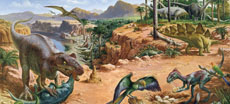 |
 |
 |
 |
 |
Produced
by the Population Genetics and Evolution class, Furman University |
||||
 |
 |
 |
 |
 |
Produced
by the Population Genetics and Evolution class, Furman University |
||||
 |
The
Jurassic: Multituberculates |
 |
||
| Multituberculates,
an order of mammals that lived during the Mesozoic Era, are rodent-like
creatures that range from the size of a mouse to the size of a beaver
(Jehle 2010). Known for being the “rodents of the Mesozoic”,
scientists also believe that Multituberculates could have been excellent
jumpers, due to their sprawling posture, and can therefore be labeled
as the “rabbits of the Mesozoic” (White and Kazlev 2010).
They were thought to be the most abundant mammals from 178-50 mya (Weil
1997). However, Multituberculates did not actually have that much in common
with modern mammals. They did have three otic ossicles in their ears,
but their way of chewing food was very different than the molars used
by mammals, today (White and Kazlev 2010). Multituberculates were the
only major branch of mammals to become completely extinct, leaving no
living descendents. They get their name from their teeth, which have many
cusps or tubercles arranged in rows (Weil 1997). Most Multituberculates
were thought to be herbivores, but some evidence shows that certain species
were able to digest meat (Jehle 2010). Multituberculates did not lay eggs,
but gave birth to immature young that was then nursed by the mother (Jehle
2010). Fossilized remains of Multituberculates have been found all over
the world, but are especially common in North America and Europe (Weil
1997).
Page by Julia Bobo |
 |
| An artists’ reconstruction of a Multituberculate, taken from: University of Bristol | |
|
Jehle M. 2010. Paleocene Mammals of the World. Accessed March 29th, 2010. White T, Kazlev MA. 2010. Mammaliformes, Multituberculates. www.palaeos.com. Accessed on March 29th, 2010. Weil A. 1997. Introduction to Multituberculates. University of California Museum of Paleontology. Accessed on March 29th, 2010. |